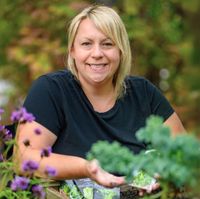Do-It-Yourself Floral Pumpkin Centerpiece

You can make a beautiful floral pumpkin centerpiece for only $13. Or even less if you use flowers from your own garden! Here are the supplies you'll need:
- Pumpkin or Large Gourd
- Vase or Mason Jar
- Pruners
- Sharp Knife
- Scissors
- Scooper
- Fresh Cut Flowers
First, measure the circumference of the vase, and cut a hole of about the same size in the top of the pumpkin. Scoop out the insides, but be sure to save them to share with the local wildlife. Set the vase inside the pumpkin, and fill it with water. Measure your flowers against the height of the pumpkin, and cut the stems so that the flowers reach just over the top of the hole. Then arrange them so they make a full bouquet, with some flowers and greenery covering the edge of the hole. If you want, supplement with more flowers from your garden until it looks just right.
This pumpkin centerpiece will serve as a beautiful fall addition to your home. Once the pumpkin starts to turn, don't throw it away! Put it outside, where the wildlife will be sure to enjoy it, too.
Get This DIY And a Dozen More of Our Favorite Fall & Winter Projects
Sign up for the Gardening Know How newsletter today and receive a free copy of our e-book "How to Grow Delicious Tomatoes".

Amy Draiss, Digital Community Manager at Gardening Know How since 2021, seamlessly blends her hands-on gardening experience with a digital green thumb. With roots in family landscaping and management at a garden center, Amy has cultivated expertise in plants, supplies, and customer relations. Residing in the Midwest, Amy tends to her two-acre haven, showcasing a diverse range of trees, shrubs, and perennials. As the Hydrangea Queen, she shares her love for these blooms and imparts gardening wisdom through videos and social media. Beyond gardening, Amy enjoys quality time with her family, travel, and theme parks. Amy's mission is to inspire and advise plant enthusiasts, fostering flourishing gardens for both seasoned and budding gardeners alike.